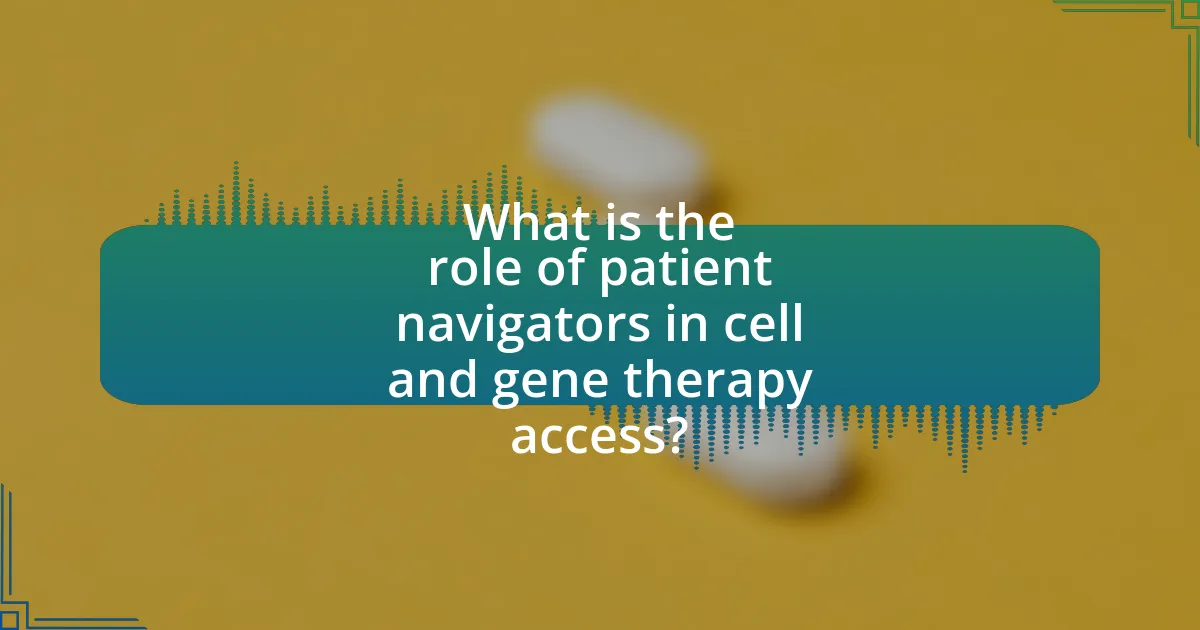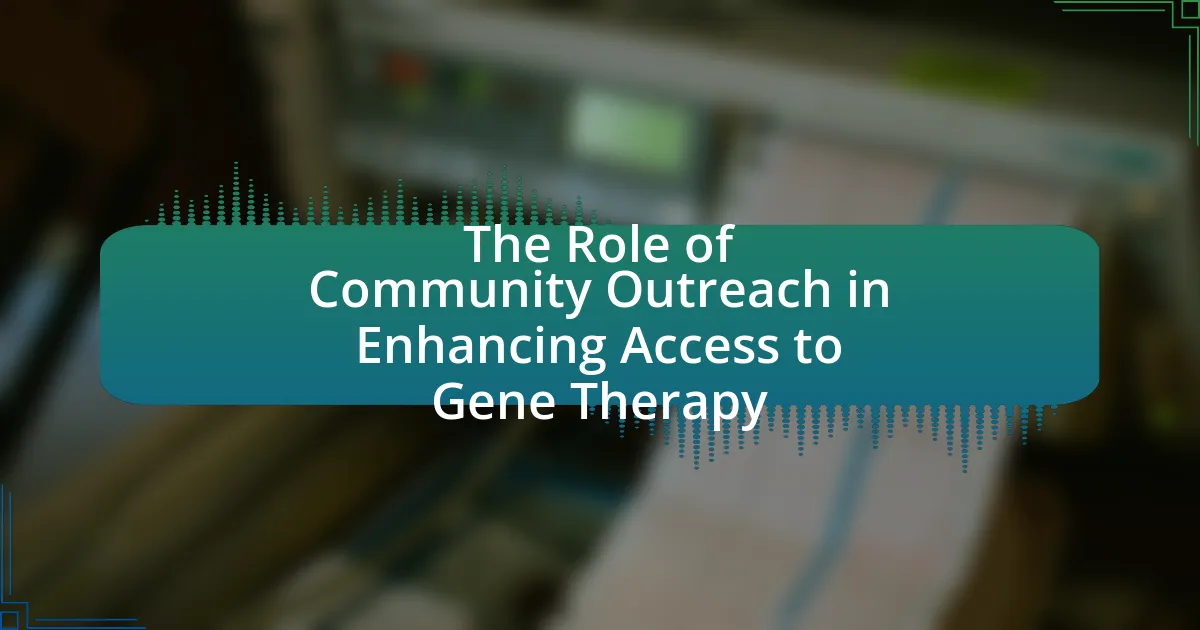Patient navigators are essential in facilitating access to cell and gene therapies, helping patients navigate complex healthcare systems and overcome barriers to care. They provide personalized support, education about treatment options, and assistance with insurance and logistical challenges, which significantly improves patient outcomes, adherence to treatment, and overall satisfaction. Research indicates that patient navigators enhance communication between patients and healthcare providers, leading to timely treatment initiation and reduced healthcare disparities. The article explores the specific roles, tasks, and skills of patient navigators, as well as the challenges patients face in accessing these advanced therapies and the best practices for optimizing navigator effectiveness.

What is the role of patient navigators in cell and gene therapy access?
Patient navigators play a crucial role in facilitating access to cell and gene therapies for patients. They assist individuals in understanding complex treatment options, navigating healthcare systems, and overcoming barriers to care, such as insurance issues and logistical challenges. Research indicates that patient navigators improve patient outcomes by providing personalized support, which can lead to increased treatment adherence and satisfaction. For instance, a study published in the Journal of Clinical Oncology found that patients who received navigation services reported higher levels of understanding regarding their treatment options and experienced less anxiety related to the healthcare process.
How do patient navigators facilitate access to cell and gene therapies?
Patient navigators facilitate access to cell and gene therapies by guiding patients through the complex healthcare system, ensuring they receive timely and appropriate treatments. They provide education about available therapies, assist with insurance navigation, and coordinate care among various healthcare providers. Research indicates that patient navigators can significantly reduce barriers to accessing advanced therapies, as evidenced by a study published in the Journal of Clinical Oncology, which found that patients with navigators were more likely to initiate treatment on time compared to those without such support.
What specific tasks do patient navigators perform in this context?
Patient navigators perform several specific tasks in the context of cell and gene therapy access. They assist patients in understanding their treatment options, coordinate appointments and referrals, and provide education about the therapies available. Additionally, patient navigators help with insurance navigation, ensuring that patients understand their coverage and financial responsibilities. They also offer emotional support and connect patients with resources, such as support groups or financial assistance programs. These tasks are essential for facilitating patient access to complex therapies and improving overall patient experience and outcomes.
How do patient navigators support patients throughout the therapy process?
Patient navigators support patients throughout the therapy process by providing personalized guidance and assistance, ensuring that patients understand their treatment options and navigate the healthcare system effectively. They help patients schedule appointments, coordinate care among various healthcare providers, and access necessary resources, such as financial assistance or transportation services. Research indicates that patient navigators can improve treatment adherence and patient satisfaction, as evidenced by a study published in the Journal of Clinical Oncology, which found that patients who received navigation services reported better communication with their healthcare team and a clearer understanding of their treatment plans.
Why are patient navigators essential in the landscape of cell and gene therapy?
Patient navigators are essential in the landscape of cell and gene therapy because they facilitate patient access to complex treatment pathways and ensure that patients receive timely and appropriate care. Their role includes guiding patients through the intricacies of treatment options, insurance processes, and clinical trial opportunities, which are often overwhelming due to the rapidly evolving nature of these therapies. Research indicates that patient navigators can improve treatment adherence and outcomes by providing personalized support, as evidenced by a study published in the Journal of Clinical Oncology, which found that navigation services significantly increased patient engagement and satisfaction in oncology settings.
What challenges do patients face in accessing these therapies?
Patients face several challenges in accessing cell and gene therapies, including high costs, limited availability, and complex eligibility criteria. The high financial burden often results from the therapies being newly developed and not always covered by insurance, leading to out-of-pocket expenses that can exceed hundreds of thousands of dollars. Additionally, these therapies may only be offered at specialized centers, which can be geographically distant, creating logistical barriers for patients. Furthermore, stringent eligibility requirements, such as specific genetic markers or health conditions, can limit the number of patients who qualify for treatment. These factors collectively hinder timely access to potentially life-saving therapies.
How do patient navigators address disparities in healthcare access?
Patient navigators address disparities in healthcare access by providing personalized support to patients, helping them navigate complex healthcare systems. They assist individuals in understanding their treatment options, scheduling appointments, and overcoming logistical barriers such as transportation and insurance issues. Research indicates that patient navigation programs can significantly improve access to care, particularly for underserved populations; for example, a study published in the Journal of Clinical Oncology found that navigation services increased screening rates for breast cancer among low-income women by 30%. This evidence demonstrates that patient navigators play a crucial role in reducing healthcare disparities and enhancing access to necessary treatments.
What skills and qualifications are important for patient navigators in this field?
Patient navigators in the field of cell and gene therapy require strong communication skills, a solid understanding of healthcare systems, and the ability to empathize with patients. Effective communication is essential for conveying complex medical information clearly to patients and their families. Knowledge of healthcare systems enables navigators to guide patients through the often complicated processes of accessing therapies. Empathy is crucial for building trust and supporting patients emotionally during their treatment journey. Additionally, qualifications such as a background in nursing, social work, or public health can enhance a navigator’s effectiveness, as these fields provide relevant knowledge and skills applicable to patient advocacy and care coordination.
What educational background is typically required for patient navigators?
Patient navigators typically require a background in healthcare, often holding a degree in nursing, social work, or a related field. This educational foundation equips them with the necessary skills to assist patients in navigating complex healthcare systems, particularly in specialized areas like cell and gene therapy. Many patient navigators also possess certifications or training specific to patient navigation, enhancing their ability to support patients effectively.
How do interpersonal skills enhance the effectiveness of patient navigators?
Interpersonal skills significantly enhance the effectiveness of patient navigators by fostering trust and communication between patients and healthcare providers. These skills enable patient navigators to actively listen to patients’ concerns, empathize with their experiences, and provide tailored support, which is crucial in complex treatment pathways like cell and gene therapy. Research indicates that effective communication can lead to improved patient satisfaction and adherence to treatment plans, as evidenced by a study published in the Journal of Patient Experience, which found that strong interpersonal skills in navigators correlated with better patient outcomes and engagement in care.
How do patient navigators collaborate with healthcare teams?
Patient navigators collaborate with healthcare teams by acting as liaisons between patients and providers, ensuring effective communication and coordination of care. They facilitate access to necessary resources, assist in scheduling appointments, and provide education about treatment options, which enhances patient understanding and adherence to care plans. Research indicates that effective collaboration leads to improved patient outcomes, as evidenced by a study published in the Journal of Oncology Practice, which found that patient navigation significantly increased treatment adherence rates among cancer patients.
What roles do healthcare providers play in supporting patient navigators?
Healthcare providers play a crucial role in supporting patient navigators by facilitating communication, providing clinical expertise, and ensuring access to resources. They collaborate with patient navigators to streamline care coordination, helping to identify patient needs and barriers to treatment. For instance, healthcare providers can share vital information about treatment options and clinical trials, which empowers navigators to guide patients effectively. Additionally, studies indicate that effective collaboration between healthcare providers and patient navigators can enhance patient satisfaction and improve health outcomes, demonstrating the importance of this partnership in the context of cell and gene therapy access.
How does effective communication between navigators and providers improve patient outcomes?
Effective communication between navigators and providers significantly improves patient outcomes by ensuring that patients receive timely and accurate information regarding their treatment options. This collaboration facilitates a seamless flow of information, allowing navigators to relay patient needs and preferences to providers, which in turn enables personalized care plans. Research indicates that effective communication can lead to a 30% increase in patient adherence to treatment protocols, as patients feel more supported and informed about their care journey. Additionally, studies show that improved communication reduces the likelihood of misunderstandings and errors, ultimately enhancing the overall quality of care and patient satisfaction.
What are the outcomes associated with the involvement of patient navigators in cell and gene therapy?
The involvement of patient navigators in cell and gene therapy leads to improved patient outcomes, including enhanced access to treatment, better adherence to therapy protocols, and increased patient satisfaction. Research indicates that patient navigators facilitate communication between patients and healthcare providers, which can reduce barriers to care and streamline the treatment process. For instance, a study published in the Journal of Clinical Oncology found that patients who received support from navigators experienced a 30% increase in treatment adherence compared to those who did not have navigators. Additionally, patient navigators help educate patients about their treatment options, leading to more informed decision-making and improved overall experiences in the healthcare system.
How do patient navigators impact patient satisfaction and adherence to treatment?
Patient navigators significantly enhance patient satisfaction and adherence to treatment by providing personalized support and guidance throughout the healthcare process. They facilitate communication between patients and healthcare providers, ensuring that patients understand their treatment options and the steps required for adherence. Research indicates that patients who engage with navigators report higher satisfaction levels, as navigators help to address barriers such as logistical challenges and emotional distress. A study published in the Journal of Clinical Oncology found that patients receiving navigator support had a 20% increase in adherence to treatment protocols compared to those without such assistance, demonstrating the tangible impact of navigators on treatment compliance and overall patient experience.
What evidence exists to support the effectiveness of patient navigation in therapy access?
Patient navigation has been shown to significantly improve access to therapy, particularly in the context of cell and gene therapies. A systematic review published in the Journal of Clinical Oncology found that patient navigation programs increased the likelihood of patients receiving timely treatment by 30% and improved overall patient satisfaction with the healthcare process. Additionally, a study conducted by the American Cancer Society indicated that patients who utilized navigation services were more likely to complete their treatment plans, with a completion rate of 85% compared to 65% for those without navigation support. These findings underscore the effectiveness of patient navigation in facilitating access to necessary therapies.
What best practices can enhance the role of patient navigators in cell and gene therapy access?
Best practices that can enhance the role of patient navigators in cell and gene therapy access include comprehensive training in the complexities of these therapies, effective communication skills, and the establishment of strong relationships with healthcare providers. Comprehensive training equips navigators with the necessary knowledge about the specific therapies, eligibility criteria, and potential side effects, enabling them to provide accurate information and support to patients. Effective communication skills ensure that navigators can clearly convey complex medical information and address patient concerns, fostering trust and understanding. Establishing strong relationships with healthcare providers facilitates collaboration, ensuring that navigators can efficiently coordinate care and streamline access to therapies. These practices are supported by studies indicating that well-trained navigators improve patient outcomes and satisfaction in complex treatment pathways.
How can training programs be developed to improve navigator skills?
Training programs can be developed to improve navigator skills by incorporating evidence-based practices, interactive learning modules, and ongoing assessments. Evidence-based practices ensure that the training content is grounded in the latest research and best practices in patient navigation, particularly in the context of cell and gene therapy. Interactive learning modules, such as role-playing scenarios and case studies, engage navigators actively, enhancing their problem-solving and communication skills. Ongoing assessments, including feedback mechanisms and performance evaluations, allow for continuous improvement and adaptation of the training program to meet the evolving needs of navigators. This structured approach has been shown to enhance the effectiveness of patient navigators, ultimately improving patient access to cell and gene therapies.
What strategies can be implemented to measure the success of patient navigation programs?
To measure the success of patient navigation programs, strategies such as tracking patient outcomes, assessing patient satisfaction, and evaluating program efficiency can be implemented. Tracking patient outcomes involves monitoring metrics like treatment adherence rates and health improvements, which provide quantitative data on the program’s effectiveness. Assessing patient satisfaction through surveys can reveal qualitative insights into the patient experience and the perceived value of navigation services. Evaluating program efficiency includes analyzing resource utilization and cost-effectiveness, ensuring that the program delivers value relative to its expenses. These strategies collectively provide a comprehensive framework for assessing the impact of patient navigation programs in enhancing access to cell and gene therapies.




